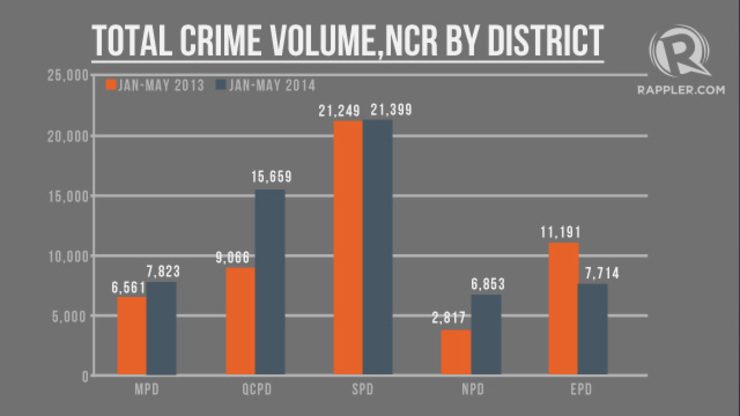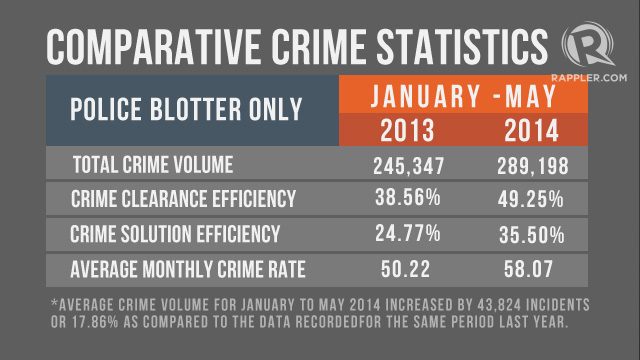SUMMARY
This is AI generated summarization, which may have errors. For context, always refer to the full article.

MANILA, Philippines – The Philippine National Police (PNP) on Friday, June 27, reported an increase in total crime volume in the first 5 months of the year compared to the same period in 2013.
From January to May 2014, the total number of crime reported was at 289,198 compared to 245,347 last year, according to data from the PNP’s Directorate for Investigation and Detective Management (DIDM).
The PNP has been criticized for the surge in crime the past few months – from mall shootings to murders and unsolved media killings.
Watch the report below.
A quick browse of the PNP’s crime statistics shows that there was also a noticeable spike in crime volume between 2008 and 2009, and again between 2012 and 2013. In the last case, the crime volume in 2013 was reported at 631,406, around triple the volume in the year before that, at 217,812.
The police organization indicated, however, that the increase in statistics did not necessarily represent a worsening peace and order situation. Among other reasons, it said, there was a possibility that local police units underreported crimes in previous years; that means the figures now are the truthful count.
Better figures?
More than a fourth of crimes reported between January and May 2014 happened in the National Capital Region (NCR). Of 59,448 reported crimes in NCR, almost half came from the Southern Police District, which covers the cities of Pasay, Makati, Parañaque, Las Piñas, Muntinlupa, and Taguig, and the municipality of Pateros.

Crime solution efficiency between January and May 2014 nationwide was at 35.5%, a rise from last year’s 26.77%.
Both figures are only from police blotters, and exclude reports from other law enforcement agencies. Crime clearance efficiency also rose from January to May 2014 compared to the same period last year – from 38.56% to 49.25%
A case is considered “cleared when at least one of the offenders has been identified,” or if the suspect has been charged before the prosecutor’s office, according to a 2009 memo from the PNP. “Cleared cases” include those that have been solved.

The PNP DIDM saw a 17.86% increase in total crime volume between January and May 2014, compared to January to May 2013. Total crime volume is the sum of reported index and non-index crimes.
Index crimes include murder, homicide, rape, robbery, and theft. Non-index crimes include estafa, prostitution, kidnapping, and carnapping.
Weak spots
The dramatic rise in numbers, PNP spokesman Chief Superintendent Reuden Theodore Sindac earlier explained, is due to a change in the methodology of recording incidents. Data from 2013, for instance, included barangay blotters and reports from other law-enforcement agencies. In previous years, only incidents reported to PNP units were counted.
In a presentation sent to media on Friday, the PNP’s DIDM cited another reason for the much lower count in previous years. It noted an “under-counting of crime incidents” because of “policies giving pressures to chiefs of police to maintain a low crime volume and high solution efficiency.”
To discourage under-reporting by local police chiefs, Sindac said crimes rates in a police officer’s area of assignment would no longer be a “basis for relief and/or recognitions such as awards.”
Prior to shifts in the methodology of recording crimes, the PNP reported a high crime solution efficiency – up to 88.37% in 2008, with an average monthly crime rate of 6.35. The crime solution efficiency was higher than countries like the United States, Japan, and Hong Kong, while the average monthly crime rate was much lower.
In 2012, the PNP reported a 36.67% crime solution efficiency. In 2013, after introducing a change in methodology, the crime solution efficiency now stood at 26.26%, with the average monthly crime rate at 85.73%.
The DIDM acknowledged the following weaknesses in crime reporting:
- varying practices in counting crime incidents
- traffic-related offenses are rarely reflected in the crime statistics
- offenses involving women and minors are under-counted
- exclusion of cases filed directly before courts
- reports of other law enforcement agencies are not considered
- wide discretion of unit commanders and investigators in deciding whether to include or exclude a crime incident in their report
- most police stations do not have official Desk (Blue) Blotter and WCPD (Pink) Blotter
Recently, Interior Secretary Manuel Roxas II announced the creation of a new “task force” to chase after “under the radar” crimes, including media killings.
Anti-crime groups have called for the sacking of PNP chief Director General Alan Purisima and Roxas, but the Palace last stood by the PNP and DILG leadership. It said the “government is firmly determined to stem the tide of criminality and improve the ability of law enforcement agencies to solve crimes.” – Rappler.com
Add a comment
How does this make you feel?
There are no comments yet. Add your comment to start the conversation.